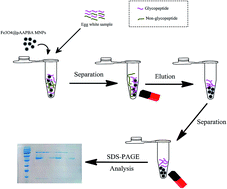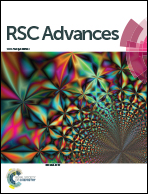Boronic acid functionalized magnetic nanoparticles synthesized by atom transfer radical polymerization and their application for selective enrichment of glycoproteins
Abstract
Biomedical sciences, especially biomarker research, strongly require an efficient glycoprotein enrichment platform. In this work, a facile novel approach is developed for the preparation of boronic acid functionalized Fe3O4 magnetic nanoparticles (MNPs) via surface-initiated atom transfer radical polymerization (ATRP). Firstly, Fe3O4 MNPs were synthesized through a solvothermal method and then the ATRP-initiator was immobilized on the surface of Fe3O4 MNPs. Finally, the poly(acrylamidophenylboronic acid) (AAPBA) functionalized Fe3O4 MNPs (Fe3O4@PAAPBA) were obtained by the ATRP technique using affinity monomer 3-acrylamidophenylboronic acid. The morphology, structure and composition of the resulting Fe3O4@PAAPBA MNPs were characterized by transmission electron microscopy (TEM), X-ray powder diffraction (XRD), Fourier transform infrared (FTIR) spectroscopy, thermogravimetric analysis (TGA), vibrating sample magnetometer (VSM) and X-ray photoelectron spectrometry (XPS). Four proteins, including ovalbumin (OVA), transferrin (Trf), lysozyme (Lyz), and horse heart cytochrome c (Cyt C) were chosen as target proteins in the adsorption performance. The binding capacity towards 1.0 mg mL−1 glycoproteins OVA and Trf is 798.1 and 278.1 mg g−1 respectively, in contrast, the adsorption of nonglycoproteins is 53.7 mg g−1 for Lyz and 30.8 mg g−1 for Cyt C. Furthermore, the adsorption–desorption cycle was repeated five times, and the Fe3O4@PAAPBA MNPs still maintain a good binding capacity. The feasibility of glycoprotein enrichment from real egg white samples by Fe3O4@PAAPBA was demonstrated. This work could provide a promising method of surface modification for the design of more efficient adsorbents for the isolation and enrichment of proteins from complex bio-samples.


 Please wait while we load your content...
Please wait while we load your content...